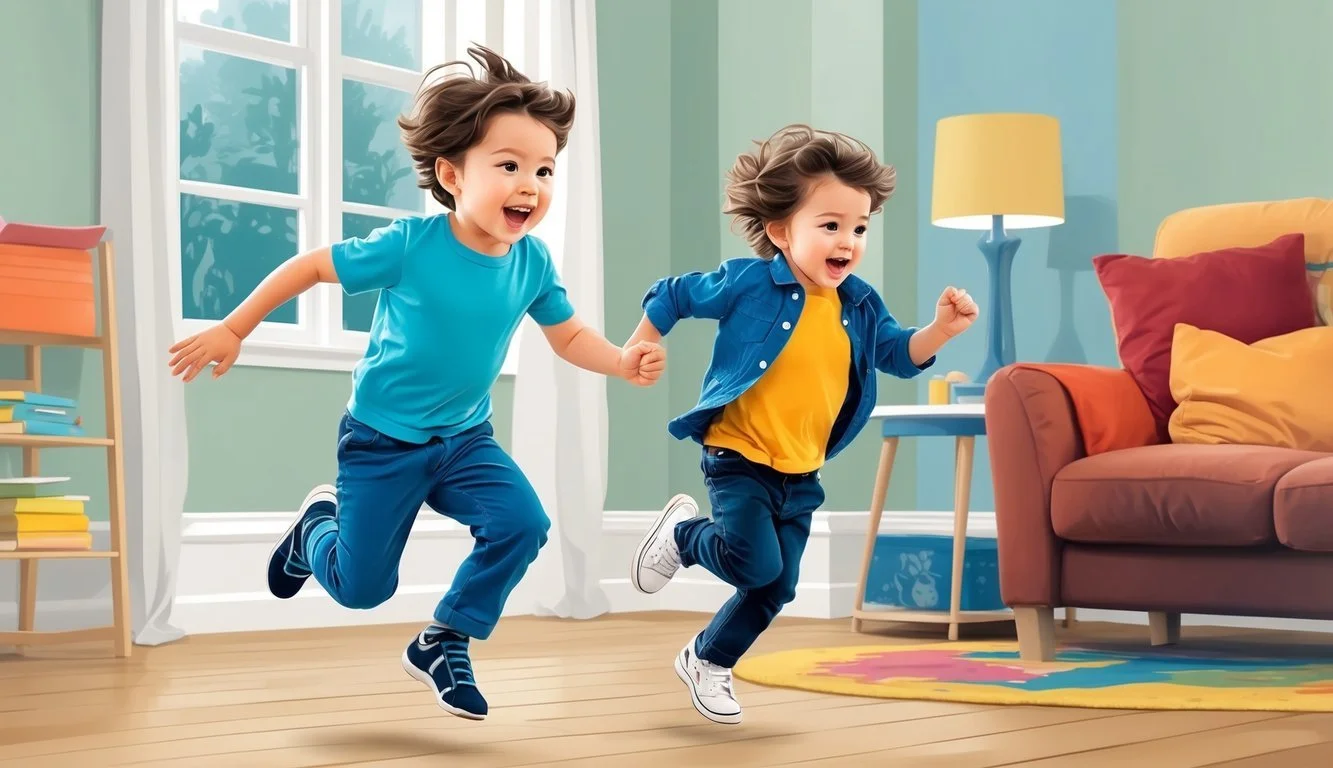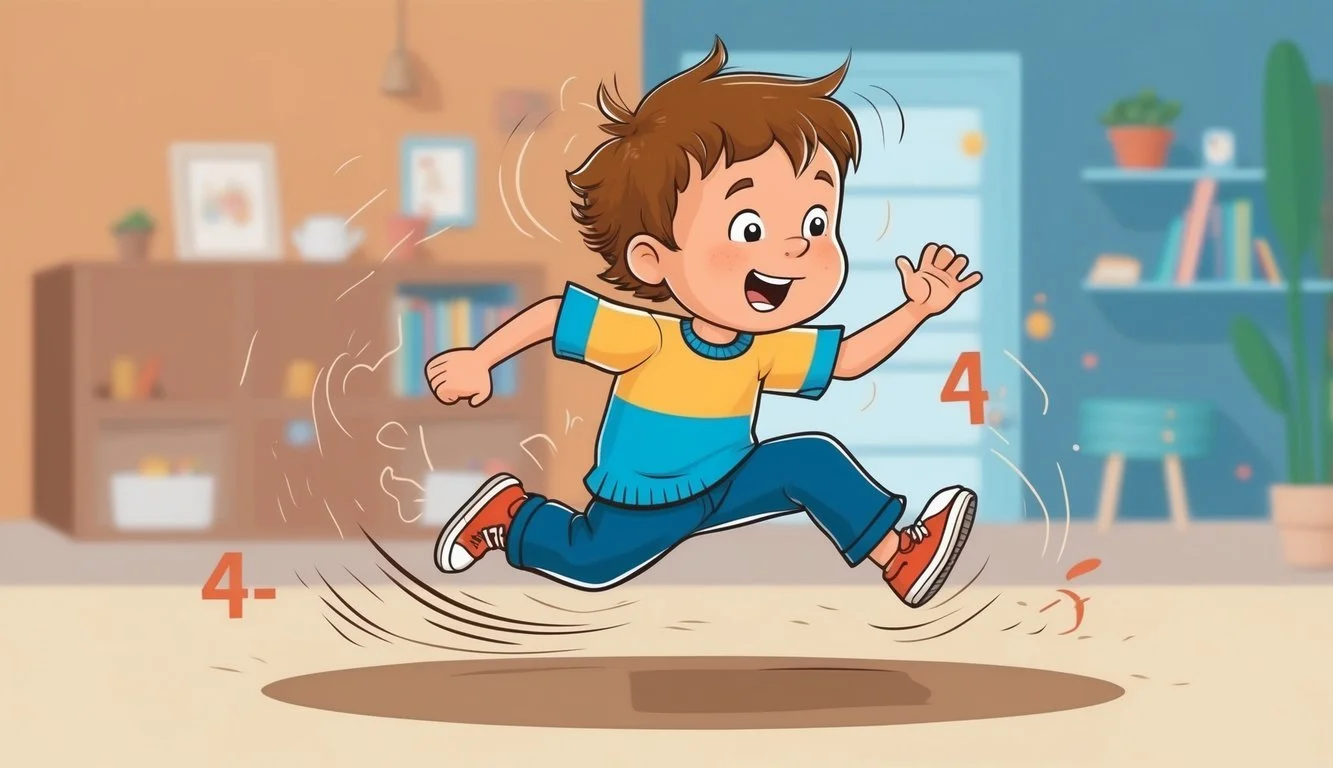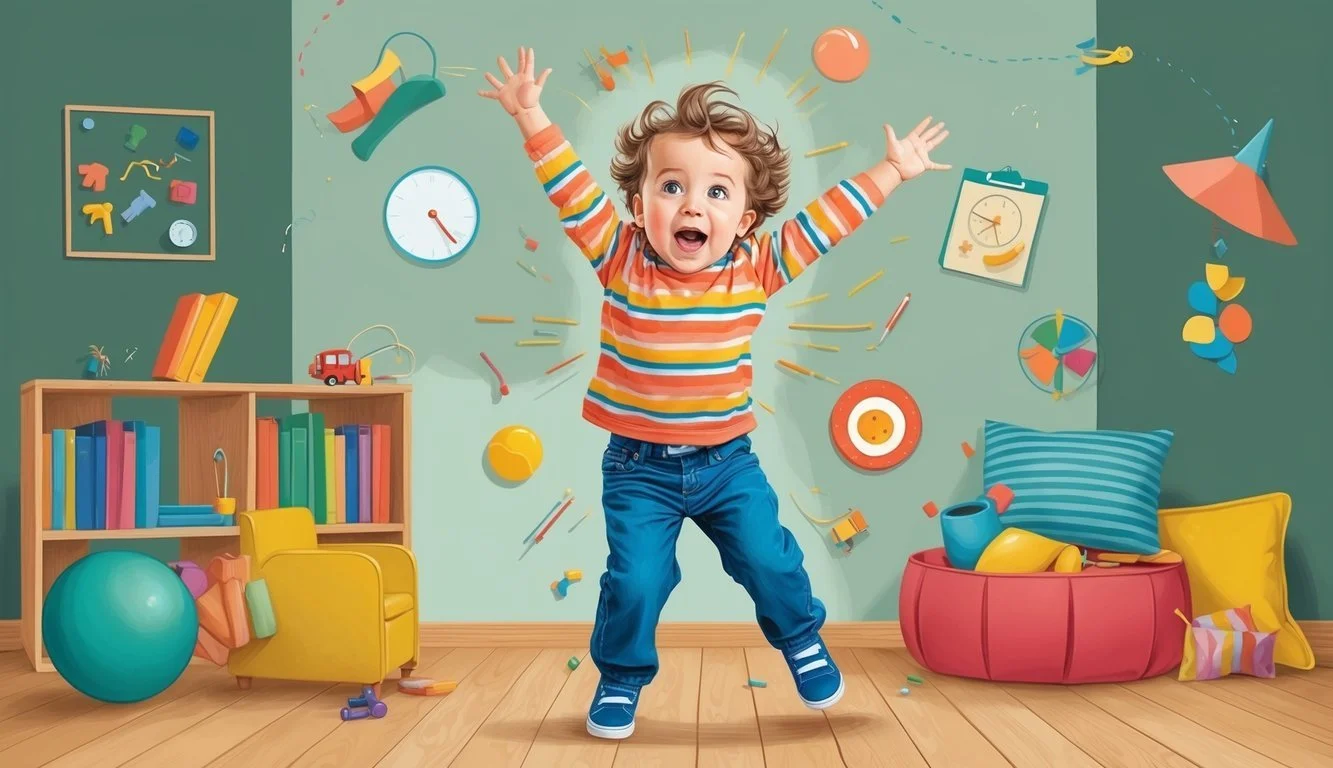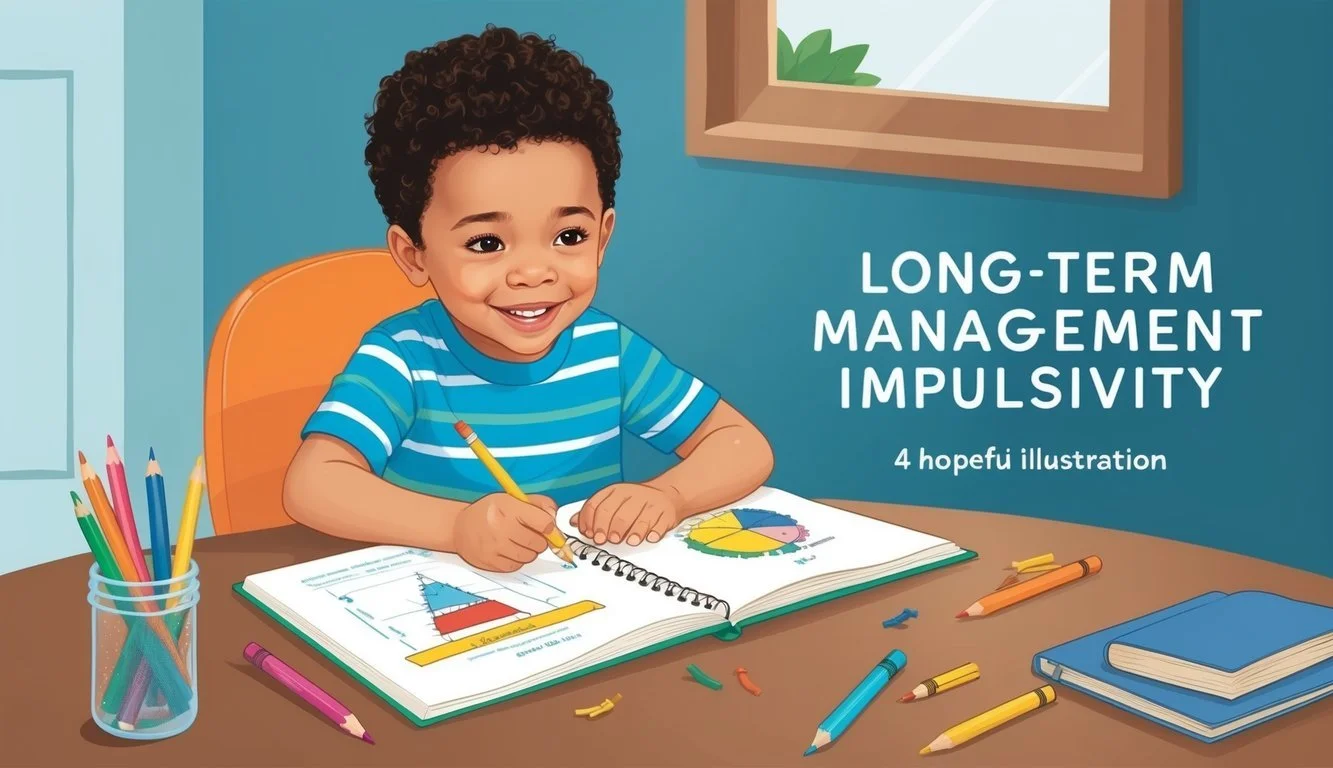Understanding Hyperactivity and Impulsivity in Your 4-Year-Old Child
Many parents of 4-year-olds find themselves wondering if their child's high energy and impulsive behavior are typical or signs of something more. While it's common for preschoolers to be active and struggle with self-control, excessive hyperactivity and impulsivity can sometimes indicate attention deficit hyperactivity disorder (ADHD).
Children with hyperactive-impulsive ADHD may exhibit symptoms such as constant fidgeting, difficulty sitting still, excessive talking, interrupting others, and acting without thinking. These behaviors can be more intense and frequent than what's typically seen in other children of the same age. It's important to note that ADHD can be diagnosed in children as young as three, although it's more commonly identified in school-aged children.
Recognizing the difference between normal preschooler behavior and potential ADHD symptoms is crucial for early intervention. While it's natural for 4-year-olds to have bursts of energy and occasional impulsive moments, consistent patterns of hyperactivity and impulsivity that interfere with daily life may warrant further evaluation by a healthcare professional.
Understanding Hyperactivity-Impulsivity in 4-Year-Olds
Hyperactivity and impulsivity are common behaviors in 4-year-olds. These traits can be part of normal development or signs of Attention Deficit Hyperactivity Disorder (ADHD).
Normal 4-year-old behavior often includes high energy levels and occasional impulsive actions. Children this age are naturally curious and active as they explore their environment.
ADHD-related hyperactivity and impulsivity in 4-year-olds may appear more intense and frequent than typical behavior. Some signs include:
Excessive fidgeting or squirming
Difficulty sitting still during meals or activities
Constant movement, running, or climbing in inappropriate situations
Talking excessively
Interrupting others frequently
Acting without thinking of consequences
It's important to note that these behaviors must be persistent, occur in multiple settings, and interfere with daily functioning to be considered potential ADHD symptoms.
Distinguishing between normal behavior and ADHD requires careful observation. Parents and caregivers should consider:
The frequency and intensity of the behaviors
How they compare to other children of the same age
Whether they cause problems at home, preschool, or in social situations
If concerns arise, consulting a pediatrician or child psychologist can help determine if further evaluation is needed. Early identification and support can make a significant difference in a child's development and well-being.
Recognizing Symptoms of Hyperactivity-Impulsivity
Hyperactivity-impulsivity in 4-year-olds manifests through specific behavioral patterns. These include constant movement, impatience, trouble with quiet activities, interrupting others, and making hasty decisions. Identifying these symptoms requires careful observation across various settings.
Excessive Movement
Four-year-olds with hyperactivity often display constant motion. They may:
Fidget or squirm when seated
Run or climb excessively, even in inappropriate situations
Have difficulty sitting still during meals or storytimes
Appear to be "driven by a motor"
Parents and caregivers might notice these children rarely walk when they can run. They may also struggle to stay in one place, moving from activity to activity quickly.
Lack of Patience
Impatience is a key indicator of hyperactivity-impulsivity in young children. Signs include:
Difficulty waiting for turns in games or activities
Frequent interruptions when others are speaking
Grabbing toys or objects from other children
Becoming easily frustrated when needs aren't immediately met
These children may struggle in situations requiring them to wait, such as standing in line or taking turns on playground equipment.
Difficulty with Quiet Activities
Children exhibiting hyperactivity-impulsivity often struggle with activities requiring stillness or quiet focus. This may manifest as:
Reluctance to engage in calm, seated activities like puzzles or drawing
Short attention span for stories or educational programs
Difficulty following instructions for quiet games
Preference for loud, active play over more subdued activities
Parents might notice these children have trouble sitting through an entire meal or resisting the urge to get up during circle time at preschool.
Interruptive Tendencies
Four-year-olds with hyperactive-impulsive traits frequently interrupt others. This behavior can be observed through:
Blurting out answers before questions are completed
Talking over others in conversations
Inserting themselves into other children's play without invitation
Difficulty waiting for their turn to speak in group settings
These children may struggle to recognize social cues indicating when it's appropriate to join conversations or activities.
Impulsive Decision Making
Impulsivity in young children often leads to quick, poorly thought-out decisions. Signs include:
Acting without considering consequences
Difficulty following safety rules
Tendency to touch or grab objects without permission
Rushing through tasks, resulting in careless mistakes
Parents might observe these children darting into traffic without looking or climbing to dangerous heights without considering the risk of falling.
Common Causes of Hyperactivity-Impulsivity
Hyperactivity-impulsivity in young children can stem from various factors. These include genetic predisposition, environmental influences, neurodevelopmental conditions, and dietary considerations.
Genetic Factors
Research indicates a strong genetic component in hyperactivity-impulsivity. Children with a family history of ADHD are more likely to exhibit these traits. Studies show that certain genes may affect neurotransmitter function and brain structure, contributing to hyperactive-impulsive behaviors.
Twin studies have revealed high heritability rates for ADHD symptoms. Specific gene variants associated with dopamine regulation play a crucial role. These genetic factors can influence a child's ability to control impulses and manage activity levels.
Environmental Influences
A child's surroundings can significantly impact hyperactive-impulsive behaviors. Exposure to toxins like lead or pesticides during pregnancy or early childhood may increase the risk. Maternal stress, smoking, or alcohol consumption during pregnancy are also linked to these behaviors.
Chaotic home environments or inconsistent parenting styles can exacerbate symptoms. Overstimulating settings may trigger hyperactivity in susceptible children. Trauma or significant life changes can also lead to heightened impulsivity and restlessness.
Early intervention and a structured environment can help mitigate these environmental factors.
Neurodevelopmental Disorders
ADHD is a primary neurodevelopmental disorder associated with hyperactivity-impulsivity. It affects brain areas responsible for executive function and self-regulation. Children with ADHD often struggle with impulse control and excessive physical activity.
Other neurodevelopmental conditions can also present with hyperactive-impulsive symptoms. These include autism spectrum disorders, sensory processing issues, and certain learning disabilities. Brain differences in these disorders can affect a child's ability to regulate behavior and attention.
Early diagnosis and appropriate interventions are crucial for managing symptoms effectively.
Diet and Nutrition
Dietary factors may influence hyperactivity-impulsivity in some children. High sugar intake and artificial food additives have been linked to increased hyperactive behaviors in sensitive individuals. Some studies suggest that omega-3 fatty acid deficiencies might contribute to ADHD symptoms.
Certain food sensitivities or allergies can also manifest as hyperactivity. Eliminating trigger foods from a child's diet may help reduce symptoms in these cases. Maintaining a balanced diet rich in essential nutrients supports overall brain function and behavior regulation.
It's important to note that dietary changes alone are not a substitute for professional medical advice or treatment.
Assessment and Diagnosis
Evaluating hyperactivity and impulsivity in 4-year-olds requires a comprehensive approach. Multiple methods and perspectives are essential for an accurate assessment, as ADHD symptoms can overlap with other conditions or typical developmental behaviors.
Professional Evaluations
Pediatricians, child psychologists, and developmental specialists play crucial roles in assessing hyperactivity and impulsivity in young children. These professionals conduct thorough interviews with parents and caregivers to gather detailed information about the child's behavior across different settings.
They observe the child's interactions and behaviors during clinical visits. This direct observation helps distinguish between age-appropriate activity levels and potential ADHD symptoms.
Professionals also review the child's developmental history, looking for patterns of behavior that may indicate ADHD or other conditions. They consider factors such as prenatal exposures, early childhood experiences, and family history of ADHD or related disorders.
Behavioral Assessment Tools
Standardized rating scales and checklists are valuable tools for quantifying hyperactive and impulsive behaviors in 4-year-olds. These instruments help measure symptom frequency and intensity across various domains.
Common assessment tools include:
Conners Early Childhood Rating Scales
ADHD Rating Scale-IV Preschool Version
Child Behavior Checklist for Ages 1.5-5
These tools provide numerical scores that can be compared to age-appropriate norms, helping clinicians determine if a child's behavior falls within typical ranges or warrants further evaluation.
Behavioral observations in structured settings, such as preschool classrooms, may also be conducted to assess the child's ability to follow instructions, interact with peers, and maintain attention during activities.
Parent and Teacher Questionnaires
Input from parents and teachers is crucial for a comprehensive assessment. Questionnaires designed for preschool-aged children gather information about behaviors observed at home and in school settings.
Parents complete forms detailing their child's behavior, developmental milestones, and any concerns they may have. These questionnaires often include questions about:
Activity levels
Attention span
Impulsivity in various situations
Social interactions
Preschool teachers or daycare providers offer valuable insights into the child's behavior in structured environments. Their observations help identify how the child functions in group settings and compares to peers.
Medical Testing
While there is no single medical test to diagnose ADHD, various examinations may be conducted to rule out other conditions that could cause similar symptoms.
A thorough physical exam checks for vision and hearing problems that might affect behavior. Blood tests may be ordered to screen for thyroid issues or lead exposure, which can impact attention and activity levels.
In some cases, neurological exams or specialized imaging studies might be recommended to investigate potential underlying causes of hyperactivity or impulsivity.
Sleep assessments may be considered, as poor sleep can exacerbate hyperactive and impulsive behaviors in young children.
Handling Hyperactivity-Impulsivity at Home
Managing a hyperactive and impulsive 4-year-old requires patience, consistency, and a structured approach. Parents can implement effective strategies to create a supportive environment that helps their child thrive while reducing challenging behaviors.
Establishing Routines
Consistent daily routines provide stability for hyperactive-impulsive children. Set regular times for meals, playtime, and bedtime. Use visual schedules with pictures or simple words to help your child understand the day's structure.
Create a bedtime routine that includes calming activities like reading stories or quiet play. This helps wind down an energetic child before sleep.
Incorporate physical activity into the daily schedule. Regular exercise can help burn excess energy and improve focus. Consider outdoor play, dance sessions, or simple obstacle courses.
Break tasks into smaller, manageable steps. This makes activities less overwhelming and helps your child stay on track.
Implementing Consistent Consequences
Clear rules and consequences are essential for guiding behavior. Explain expectations in simple terms and be consistent in enforcing them.
Use natural consequences when possible. For example, if toys aren't put away, they become temporarily unavailable.
Implement a time-out system for more serious infractions. Keep time-outs brief - about one minute per year of age is often effective.
Avoid long lectures or punishments. Brief, clear responses work best for maintaining focus and understanding.
Praise good behavior immediately and specifically. This reinforces positive actions and encourages their repetition.
Creating a Supportive Home Environment
Organize the home to minimize distractions. Create designated spaces for different activities like homework, play, and quiet time.
Reduce clutter and keep toys organized in labeled bins. This helps your child focus and promotes independence in finding and putting away items.
Establish a quiet zone for when your child needs to calm down. Include comforting items like soft pillows or stress balls.
Limit screen time and choose educational, age-appropriate content when screens are used. Excessive screen time can exacerbate hyperactivity and impulsivity.
Use noise-canceling headphones or white noise machines to help your child concentrate during quiet activities if external noises are distracting.
Using Positive Reinforcement
Implement a reward system for good behavior. Use sticker charts or token systems to track progress towards goals.
Offer immediate praise for positive actions. Be specific in your compliments, highlighting exactly what was done well.
Use small, frequent rewards rather than large, infrequent ones. This helps maintain motivation and reinforces desired behaviors more consistently.
Incorporate your child's interests into rewards. For example, extra playtime with a favorite toy or a special outing to a beloved park.
Celebrate improvements, no matter how small. Recognizing progress boosts self-esteem and encourages continued effort.
Treatment Options
Several approaches can help manage hyperactivity and impulsivity in 4-year-olds. These interventions aim to improve behavior, enhance focus, and support overall development.
Behavioral Therapy
Behavioral therapy techniques are effective for young children with hyperactivity and impulsivity. Therapists work with kids to develop coping strategies and improve self-control. Common methods include:
Positive reinforcement
Token reward systems
Time-out procedures
These strategies help children learn appropriate behaviors and manage impulses. Therapists may use play-based activities to engage 4-year-olds effectively. Sessions often involve parents to ensure consistency at home.
Cognitive-behavioral therapy (CBT) can be adapted for preschoolers. It focuses on identifying and changing negative thought patterns. This approach helps children understand the link between thoughts, feelings, and actions.
Medication
Medication is not typically the first-line treatment for 4-year-olds with hyperactivity and impulsivity. The American Academy of Pediatrics recommends behavior therapy as the initial approach for children under 6.
In some cases, doctors may consider medication for severe symptoms that significantly impact daily life. Stimulant medications like methylphenidate are most commonly prescribed. These drugs can help improve focus and reduce hyperactive behaviors.
Non-stimulant medications are another option. They may have fewer side effects but can take longer to show results. Any medication use in young children requires careful monitoring by a healthcare professional.
Parent Training Programs
Parent training programs are crucial in managing hyperactivity and impulsivity in 4-year-olds. These programs teach parents effective strategies to:
Set clear rules and expectations
Use consistent discipline techniques
Provide positive reinforcement
Create structured routines
Parents learn to implement behavioral strategies at home, reinforcing skills learned in therapy. Many programs use role-playing exercises to practice new techniques.
Group-based parent training can offer additional benefits. It provides a support network and allows parents to share experiences and strategies.
Alternative Therapies
Some families explore alternative therapies to complement traditional treatments. These may include:
Dietary modifications (e.g., reducing sugar intake)
Omega-3 fatty acid supplements
Mindfulness and relaxation techniques
While research on these approaches is limited, some children may benefit. Occupational therapy can help with sensory processing issues often associated with hyperactivity.
Physical activities like yoga or martial arts may improve focus and self-control. These practices combine movement with mindfulness, potentially benefiting hyperactive children.
It's important to discuss any alternative therapies with a healthcare provider before implementation. They can advise on potential benefits and risks for young children.
Educational Strategies and Support
Effective educational strategies and support are crucial for helping 4-year-olds with hyperactivity and impulsivity. These approaches focus on creating structured environments, tailoring instruction, and implementing targeted interventions to promote learning and behavioral success.
Classroom Management Techniques
Establishing clear routines and expectations is essential for managing hyperactive and impulsive behaviors in young children. Visual schedules and cues can help 4-year-olds understand daily activities and transitions. Teachers can use timers to break tasks into shorter segments, allowing frequent movement breaks.
Seating arrangements play a vital role. Placing hyperactive children near the teacher or away from distractions can improve focus. Fidget tools or stress balls may help some children channel excess energy constructively.
Positive reinforcement systems, such as sticker charts or token economies, encourage desired behaviors. Immediate and specific praise for following instructions or completing tasks can boost motivation and self-esteem.
Individualized Education Plans
Individualized Education Plans (IEPs) are tailored to meet the unique needs of 4-year-olds with hyperactivity and impulsivity. These plans outline specific goals, accommodations, and support services.
Common accommodations may include:
Extra time for tasks
Simplified instructions
Frequent check-ins with teachers
Use of assistive technology
IEPs often incorporate strategies to develop self-regulation skills, such as teaching deep breathing techniques or using visual reminders for appropriate behavior. Regular progress monitoring allows for adjustments to ensure the child's needs are consistently met.
Collaboration between parents, teachers, and specialists is crucial for developing and implementing effective IEPs.
School-Based Interventions
School-based interventions focus on providing additional support within the educational setting. Social skills groups can help 4-year-olds with hyperactivity and impulsivity learn appropriate peer interactions and impulse control.
Occupational therapy may be beneficial for addressing fine motor skills and sensory processing issues. Speech and language therapy can support communication skills and following verbal instructions.
Behavioral interventions, such as cognitive-behavioral therapy adapted for young children, can teach coping strategies and problem-solving skills. These interventions often involve role-playing and practice in real-life situations.
Schools may implement small group instruction or one-on-one support to provide more individualized attention and reduce distractions. This targeted approach allows for immediate feedback and reinforcement of positive behaviors.
Community and Social Support
Building a supportive community network is crucial for families with hyperactive and impulsive 4-year-olds. Various resources and programs can provide education, understanding, and opportunities for socialization.
Support Groups and Networks
Local ADHD support groups offer a valuable space for parents to connect and share experiences. These groups often host meetings where parents can discuss challenges, exchange tips, and find emotional support. Online forums and social media communities provide 24/7 access to advice and encouragement from others in similar situations.
Many hospitals and mental health centers organize parent training workshops. These sessions teach effective strategies for managing hyperactive behaviors and improving parent-child interactions.
Pediatricians and child psychologists may also recommend reputable support networks and resources tailored to families' specific needs.
Recreational Programs
Structured recreational activities can help channel a hyperactive child's energy positively. Many communities offer specialized programs designed for children with attention and impulse control challenges.
Sports teams focusing on individual skills, like swimming or gymnastics, can be beneficial. These activities provide physical outlets while teaching discipline and focus.
Art classes and music lessons offer creative expression opportunities and can improve concentration. Some programs use mindfulness techniques to help children develop self-regulation skills.
Libraries often host storytimes and interactive sessions that accommodate different attention spans and energy levels.
Public Awareness Initiatives
Increasing public understanding of hyperactivity and impulsivity in young children is essential for creating a supportive community environment. Local schools and daycare centers may organize information sessions for staff and parents to educate about these behaviors.
Community health fairs often feature booths with resources on child development and ADHD. These events provide opportunities for families to learn and connect with local services.
Some organizations run campaigns to reduce stigma and promote acceptance of neurodiversity. These initiatives may include public service announcements, informational brochures, and community events celebrating different learning and behavior styles.
Long-Term Management and Outlook
Managing hyperactivity and impulsivity in 4-year-olds requires ongoing attention and adaptation as children grow. Effective long-term strategies focus on monitoring developmental progress, preparing for adolescent transitions, and accessing appropriate support systems.
Monitoring Developmental Milestones
Regular assessments help track a child's progress and identify areas needing additional support. Parents and healthcare providers should work together to monitor cognitive, social, and emotional development.
Periodic evaluations by specialists can help adjust treatment plans as needed. These may include assessments of:
Language skills
Motor coordination
Social interactions
Academic performance
Early intervention strategies often need refinement as children mature. Behavioral therapies and educational accommodations may require updates to address changing needs.
Transitioning to Adolescence
As hyperactive and impulsive children approach adolescence, new challenges often emerge. Preparing for this transition is crucial for long-term success.
Key areas to focus on include:
Self-regulation skills
Time management
Organization techniques
Study habits
Encouraging independence while maintaining appropriate support becomes increasingly important. Parents and educators should gradually increase responsibilities while providing guidance.
Discussing puberty and its potential impact on symptoms is essential. Hormonal changes may affect behavior and require adjustments to management strategies.
Ongoing Support and Resources
Continuous access to resources and support networks is vital for long-term management. Parents should stay informed about current research and treatment options.
Helpful resources may include:
Support groups for parents and children
Educational workshops
Online communities
Maintaining open communication with schools ensures consistent support across environments. Regular meetings with teachers and counselors can help address emerging issues promptly.
As children grow, involving them in decision-making regarding their treatment becomes increasingly important. This promotes self-awareness and encourages active participation in managing their symptoms.










